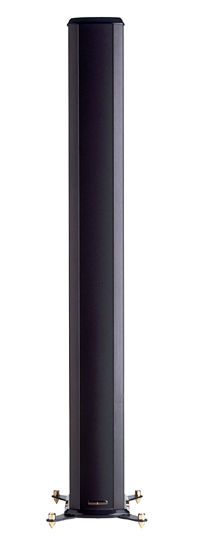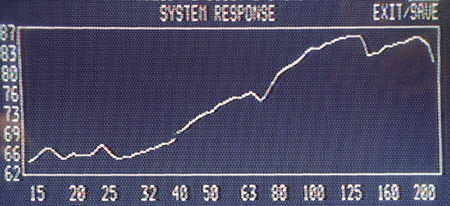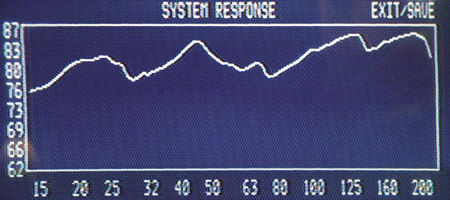| Columns Retired Columns & Blogs |
Bohlender-Graebener Radia 520i loudspeaker
Loudspeaker cabinet design has been strongly influenced by home theater. Large floorstanding cabinets, required for reproduction of bass frequencies, are being replaced by tall, graceful towers with small footprints. While these slim speakers fit more easily into home décor and living spaces, to fill out their bass response they depend on being used with the subwoofers that are standard in multichannel systems.
 Igor Levitsky, speaker designer for Bohlender-Graebener Corp. (aka BG Corp.), has taken advantage of the slim tower motif in the design of the Radia 520i speaker, which has a 50" midrange-tweeter ribbon driver. This narrow driver offers wider horizontal dispersion than a panel speaker, while suppressing strong early reflections from the floor and ceiling by acting as a line source. A line-source speaker radiates a cylindrical wavefront, which suffers milder propagation losses than does a conventional cone driver. Levitsky mounted the 520i's ribbon driver in a tall, open aluminum frame to minimize cabinet resonance effects.
Igor Levitsky, speaker designer for Bohlender-Graebener Corp. (aka BG Corp.), has taken advantage of the slim tower motif in the design of the Radia 520i speaker, which has a 50" midrange-tweeter ribbon driver. This narrow driver offers wider horizontal dispersion than a panel speaker, while suppressing strong early reflections from the floor and ceiling by acting as a line source. A line-source speaker radiates a cylindrical wavefront, which suffers milder propagation losses than does a conventional cone driver. Levitsky mounted the 520i's ribbon driver in a tall, open aluminum frame to minimize cabinet resonance effects.
The 520i's ribbon covers the spectrum above 350Hz and fires through a 30mm-wide slot in an aluminum frame. The ribbon itself consists of a diaphragm of polymer film strung with aluminum conductors, which carry the audio signal, suspended between push-pull magnet arrays. Levitsky complements the ribbon with two 6.5"-cone woofers mounted in the 520i's 7.75" by 13.75" lower enclosure, made from MDF. These provide bass down to 70Hz. The crossover uses modified fourth-order Linkwitz-Riley filters, with an in-phase driver connection.
Some assembly is required before the Radias can be used. The tall, thin towers must be anchored to their flat brass bases with ¼" hex-head screws. Four legs extend out from the base, each tipped with a sharp spike. Top caps are then mounted on each speaker column. (The caps are packed separately so that the 520i box keeps within UPS's maximum package length.) Although not described in the accompanying information sheets, the metal brackets at the back of each plastic cap must be slid under two mounting screws at the top of the speaker column. The front and back grilles can be removed by pulling them up and lifting them out of their black anodized rails—sort of like unzipping a zipper.
Setup & fine-tuning
I set up the Bohlender-Graebener Radia 520i's in the exact spots usually occupied by my reference Quad ESL-989s: 8' apart, 5' from the back wall, and 3' 9" from the side walls. Moving the BGs into position, I was struck by the towers' height (over 70"), narrowness (under 8"), and relative lightness (59 lbs). I did my listening in my lightly damped, rectangular listening room, which is 26' long, 13' wide, and 12' high. Behind my listening chair, the other end of the room opens into a 25' by 15' kitchen. All listening was done with the BGs' grilles in place. For purposes of stability, I left the spikes in the floor stands.
First, I had to decide: Did I need a subwoofer for this review? Without a sub, the BG Radia 520i generated a wide soundstage, with a smooth upper midrange and highs and fast, accurate sound. On first listen, I was surprised and pleased to find that the 520i also had a fast, true upper-bass response. For soloists and for some percussion, I didn't miss the bass extension. But the lack of the deep bass on recordings that feature bass drum and pipe-organ pedal tones made such music less dramatic and involving. In addition, the 520i's two woofers grew mildly distorted when driven extremely hard with bass drum passages or rock music. Deep, powerful bass drum notes, in particular, seemed muffled and distant, and greatly changed in tonality. I decided to listen with and without a subwoofer.
True, I'd used the BG Radia 520i in the final listening sessions for my review of Revel's Sub 30 subwoofer (Stereophile, November 2004). The Sub 30 had been placed in the right rear corner, behind the plane of the Radias. A pair of stereo interconnects ran from the Mark Levinson ML-7a preamplifier to the line-level right and left inputs on the Sub 30's rear panel. The Sub 30's high-pass filter was set to 80Hz and 12dB/octave, its low-pass filter to 80Hz and 48dB/octave, its Contour switch to Music. Interconnects were run from the Sub 30's right and left output jacks to a pair of Mark Levinson ML-2 power amplifiers, which drove the BGs.
When I first set up the Radias with the Revel sub, the phase and channel-identification checks on Stereophile's first Test CD (Stereophile STPH002-2) revealed that the BGs' phase was inverted. Eric Graul, production manager at BG Corp., helped me track down the problem: the Revel Sub 30's electronics inverted phase. When driven directly from the preamplifier, the 520is were in phase. Whenever I added the Revel to the system, I set its Phase control to 180 degrees.
I then used the built-in signal generator, microphone, and virtual spectrum analyzer of a Velodyne DD-18 subwoofer to evaluate the BG 520i's in-room frequency response at my listening position with and without the Revel subwoofer. (Velodyne's technology is not part of the BG 520i's or Revel Sub 30's standard installation packages; see Stereophile, June 2004, p.133.) I set up the Velodyne's calibration microphone on the back of my listening chair at my ear level, 37" from the floor, and set the DD-18's volume control to "0" so that it would put out no audio signal. I then keyed the Velodyne's remote control to display its System Response screen on my TV monitor. This automatically initiates a repeated sweep tone from the DD-18's signal generator, which is then fed into a tape input on my preamp. When I drove the BG 520i without the subwoofer (fig.A), its frequency response showed peaks at 180Hz and 125Hz, falling gradually below that point, to -3dB at 90Hz and -10dB at 60Hz. Adding the Revel Sub 30 extended the response down to 20Hz, ±6dB (fig.B).

Fig.A BG Radia 520i, in-room response, 15-200Hz (4dB/vertical div.).

Fig.B BG Radia 520i with Revel Ultima Sub 30, in-room response, 15-200Hz (4dB/vertical div.).
- Log in or register to post comments




































